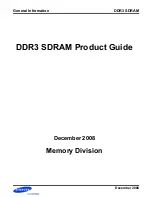
Lightweight HPS-to-FPGA Bridge
The master interface into the FPGA fabric operates in the
h2f_lw_axi_clk
clock domain provided by
custom logic in the FPGA fabric. The slave interface of the bridge in the HPS logic operates in the
l4_mp_clk
clock domain. The bridge provides clock crossing logic that allows the logic in the FPGA to operate in any
clock domain, asynchronous from the HPS.
The lightweight HPS-to-FPGA bridge has one reset signal,
lwhps2fpga_bridge_rst_n
. The reset
manager drives this signal to the lightweight HPS-to-FPGA bridge on a cold or warm reset.
Related Information
•
on page 2-1
For information about the l3_main_clk and l4_mp_clk clocks, refer to the
Clock Manager
chapter.
•
on page 3-1
For more information about the reset manager, refer to the
Reset Manager
chapter.
•
on page 28-1
For information about the f2h_axi_clk clock, refer to the
HPS Component Interfaces
chapter.
GPV Clocks
The FPGA-to-HPS and HPS-to-FPGA bridges have GPV slave interfaces, mastered by the lightweight
HPS-to-FPGA bridge. These interfaces operate in the
l4_mp_clk
clock domain. Even if you do not use
the lightweight HPS-to-FPGA bridge in your FPGA design, you must ensure that a valid
l4_mp_clk
clock
is being generated, so that the GPV registers in the HPS-to-FPGA and FPGA-to-HPS bridges can be
programmed. The GPV logic in all three bridges is in the
l4_mp_clk
domain.
Related Information
on page 5-3
Data Width Sizing
-The HPS-to-FPGA and FPGA-to-HPS bridges allow 32-, 64-, and 128-bit interfaces to be exposed to the
FPGA fabric. For 32-bit and 128-bit interfaces, the bridge performs data width conversion to the fixed 64-bit
interface within the HPS. This conversion is called
upsizing
in the case of data being converted from a 64-bit
interface to a 128-bit interface. It is called
downsizing
in the case of data being converted from a 64-bit
interface to a 32-bit interface. If an exclusive access is split into multiple transactions, the transactions lose
their exclusive access information.
During the upsizing or downsizing process, transactions can also be resized using a data merging technique.
For example, in the case of a 32-bit to 64-bit upsizing, if the size of each beat entering the bridge’s 32-bit
interface is only two bytes, the bridge can merge up to four beats to form a single 64-bit beat. Similarly, in
the case of a 128-bit to 64-bit downsizing, if the size of each beat entering the bridge’s 128-bit interface is
only four bytes, the bridge can merge two beats to form a single 64-bit beat.
The bridges do not perform transaction merging for accesses marked as noncacheable.
You can set the
bypass_merge
bit in the GPV to prevent the bridge from merging data and
responses. If the bridge merges multiple responses into a single response, that response is the one
with the highest priority. The response types have the following priorities:
Note:
HPS-FPGA AXI Bridges
Altera Corporation
cv_54005
Lightweight HPS-to-FPGA Bridge
5-14
2013.12.30
















































